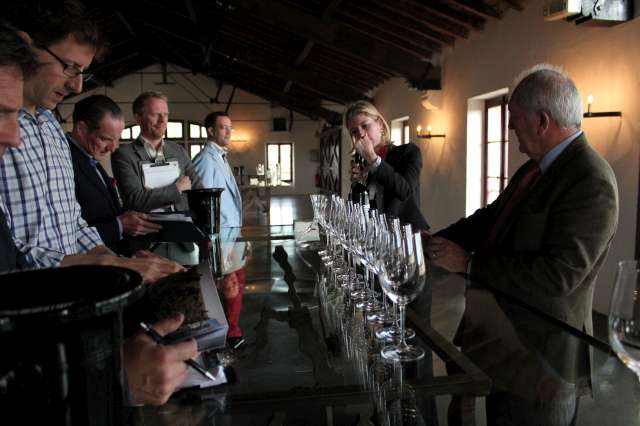
2013 is a challenging year for the red wines of Bordeaux but a good year for the dry white wines and an excellent one for the sweet wines of Sauternes and Barsac.
The reds suffered from a difficult flowering period and a cold and wet Spring and early Summer. July and August were hot but sometimes stormy. September and October were rainy months which resulted in serious problems of rot. This forced many growers to pick their grapes some 10-14 days before they would ideally liked to have done so. Most of the top Châteaux now have the ability to eliminate rotten grapes from their wines by the use of sorting tables but there is little that can be done (apart from adding some sugar) to wines that are weak and over-acidic. Most grapes were picked at less than optimum ripeness. Thanks to modern wine-making techniques the vintage was saved from being a disaster of 1992, 1984 or 1977 proportions. Most Châteaux have made around half their normal production but La Lagune, Quinault L'Enclos and Hosanna have made nothing. Le Pin are undecided about what to do with their 3 good barrels!
If we had to make a general description of 2013 red Bordeaux, it would be that the wines have light colours, pleasant red fruit (strawberries and raspberries appear over and over again in our tasting notes) and high acidity. You will read words like "elegant", "charming" and "refreshing" used by critics this year. Thanks to the heat of July we noticed very little greenness in the wines but, with a few exceptions, not much richness and flesh either. These will be wines for early drinking as long as consumers don't mind their wines being a little delicate and with brisk acidity.

Well-managed vineyards, where grapes naturally achieve ripeness earlier, have certainly done better than those where an Indian summer is important for achieving ripe fruit. This is particularly the case in Pomerol where there is no Cabernet Sauvignon. In general the Médoc is the weakest area - especially the Margaux appellation. It's a long time since Bordeaux had a poor vintage for its red wines but, with a few notable exceptions, this is the weakest vintage, overall, since 1997. Maybe it will, in time, turn out to be as good as 2002, 2004 and 2007 but I doubt it. Most wines will never be able to shake off their searing acidity and lack of flesh on the mid-palate.
A successful en primeur campaign depends not just on the quality of the wines but also the prices and market demand. It seems it's not just the weather that will scupper this en primeur campaign.

With yields dramatically lower than normal, it is not uncommon to find producers with half their normal production levels. This is hardly conducive to lower pricing. Allied to this there is undoubtedly not much consumer interest. Customers spent vast amounts of money on the outstanding, but very expensive, 2009s and 2010s and then there were the decent 2011's and really quite good 2012's which are still available at their original release prices. Nobody needs to buy en primeur in 2013 - except maybe those with children born this year or those who follow the wines of particular Châteaux every year without fail. What is for sure is that virtually no red 2013 Bordeaux is even worth considering unless it is significantly cheaper (20%+) than the same property's wine in, for example, the attractive 2007 vintage. Unfortunately the campaign has opened with two Châteaux who made a couple of the finest wines of the 2012 vintage (Pontet Canet and Gazin) releasing at virtually the same price as last year. They both made decent wines in 2013 but they are certainly not up to the standard of their 2012's.
For those who would like to have a few 2013's in their cellar then we would recommend a handful of wines that have a depth of fruit that can cope with the tightness of structure. These would include Domaine de Chevalier, Roc de Cambes, Le Tertre Rôteboeuf, L'Eglise Clinet, Les Cruzelles and La Chenade. In the Médoc Châteaux such as Léoville Barton and Lynch Bages have at least made wines worthy of their names.
Nearly all of the dry white wines can be bought with confidence as they have a lovely balance of ripe melon, pineapple and citrus fruit allied with crisp acidity. The top sweet wines have fabulous richness and freshness thanks to the ideal combination of noble rot and acidity. It's no surprise that Yquem is our wine of the vintage. The Sauternes are up to the level of the excellent 2007 vintage and may even touch the quality level of 2001.

Nevertheless, the Farr Vintners sales and purchasing team travelled to Bordeaux this year and tasted hundreds of wines during our visit. As well as providing our customers with our assessment of each wine, we will also show the current 2007 price of each wine for your reference and estimates for 2013. In most cases the wines will need to be offered at bargain, low-estimate prices to attract any market interest. Despite the fact that we are an en primeur specialist, we feel that our main role as your wine merchant is to advise you to purchase conservatively in 2013 and to only consider the very best wines of the vintage unless prices prove irresistible.
Photos by Sam Browett.
One of the best technical reports on the vintage is written by the Cazes family of Château Lynch Bages that we are pleased to show here.